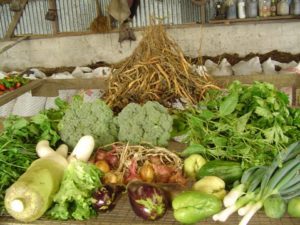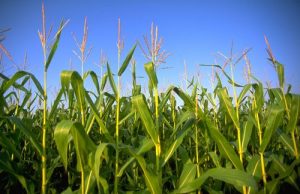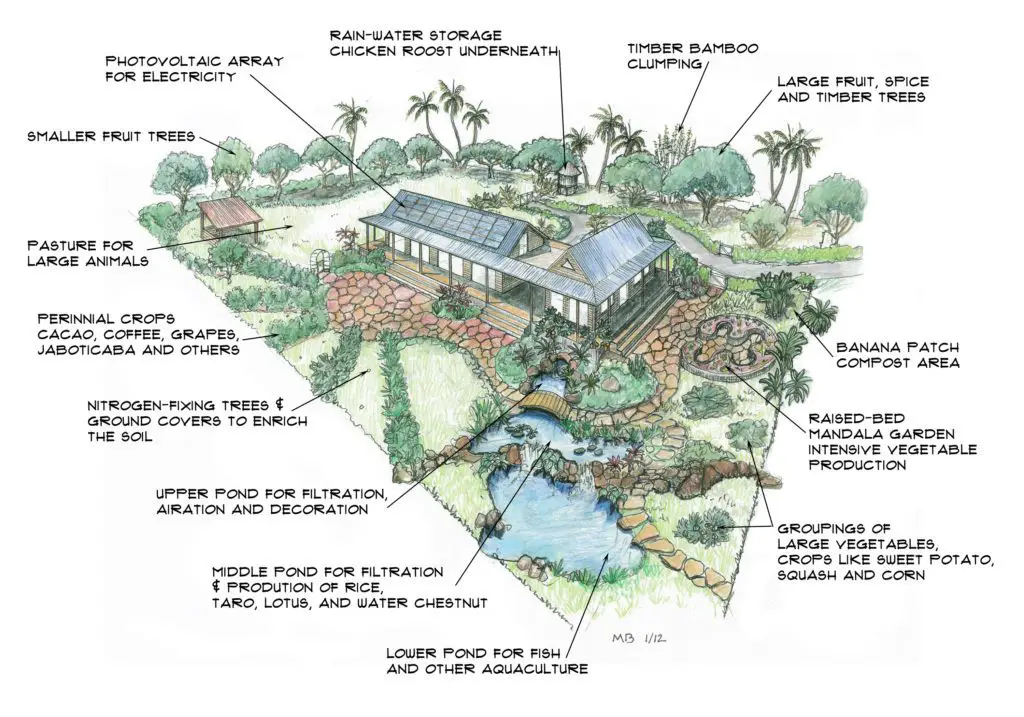You do not have to lose curb appeal to have a self-sufficient homestead as Mykal Blueskyes illustrates to you in his lovely rendering here.
Views differ from one to another on how to build a self-sufficient lifestyle, and the amount of space necessary to build a self-sustaining homestead. This is my version of what it would take for a family of four to live off a one acre tract of land in Costa Rica. This is the minimum amount of land, however, to add another acre or two would make life easier depending on what level of independence you wish to achieve.
Given the fact we all have different needs and requirements in our daily lives, each situation will differ. Each family will take a different approach, and it’s unlikely any two 1- acre farms will be alike. And you don’t want them to be alike so that there is a basis for trade which helps build community as well.
 In the illustration, Mykal Blueskyes has included areas for cows, chickens and other farm animals, but these animals are not necessary to complete a self-sustaining homestead. Without animals there is more space for growing legumes, fresh vegetables and fruits. However, a vegan self-sustaining situation will require organic fertilizers, and this can be achieved by using nitrogen fixing trees and cover crops, proper composing and ponds it is easier and more efficient to build fertile soil without animals. If you think about it all an animal does is process plant material, extract the energy it needs for itself and returns the rest of it to the ground, if you are composting that same plant material you are keeping all of that energy, nutrients and minerals in the system. In healthy soil you will find all of the bacterial and yeasts that are found in animals digestive systems. Many vegan mini-farmers create fertile soil without the addition of animal waste by using this method.
In the illustration, Mykal Blueskyes has included areas for cows, chickens and other farm animals, but these animals are not necessary to complete a self-sustaining homestead. Without animals there is more space for growing legumes, fresh vegetables and fruits. However, a vegan self-sustaining situation will require organic fertilizers, and this can be achieved by using nitrogen fixing trees and cover crops, proper composing and ponds it is easier and more efficient to build fertile soil without animals. If you think about it all an animal does is process plant material, extract the energy it needs for itself and returns the rest of it to the ground, if you are composting that same plant material you are keeping all of that energy, nutrients and minerals in the system. In healthy soil you will find all of the bacterial and yeasts that are found in animals digestive systems. Many vegan mini-farmers create fertile soil without the addition of animal waste by using this method.
For the non-vegan mini-farmer, on a 1- acre farm with rich, well-drained land, you may have a Jersey cow for milk, cream, butter and cheese, a few chickens, I suggest up to 12 chickens for a family of 4. You could have a pig or two but the smell can be harsh if not placed in the furthest corner of your property. Goats can keep you in milk when your Jersey is not lactating. Not only do these animals keep you stocked in healthy fresh dairy products, but will also keep your lawn, flower and vegetable gardens fertilized. Waste not, want not!
Many ask how can I make money to buy the staples, depends on what scale you decide to buy out instead of making at home. Often there is surplus, milk, cream, butter and cheeses to sell off as well as surplus animals and often meat. Once again, to what level a person wants to take this will determine the end results. The amount of by-products left over from your cow, goat and pigs will surprise you when you go to sell them. A tropical mini-farm offers you more options such as, many tropical forms of starch like taro, cassava, jack-fruit and many edible leaved trees that can take the place of the traditional grains. Rice can be grown at higher elevations too, if there is sufficient rainfall or a consistent water source, you are in business.
In order to write this from experience, I purchased a dairy cow and she is milked daily, I have made the best butter, I have cream for my coffee and we all look forward to the cheeses made from this fresh raw milk. I never knew how much better a glass of cold, fresh, raw milk would taste after drinking pasteurized milk my entire life. A good milk cow is a definite to keep you and your family healthy and happy. To learn more on cheese making and how to purchase kits and supplies go to: http://thecheesemaker.com/ I once thought it hard to make blue cheese, brie, Sharpe cheddar and others, but here you see just how easy it can be, and the results are oh so rewarding, not to mention economical given what cheese sells for in the stores these days.
Oddly enough I enjoy milking the cow! Yes, it takes about 10 minutes and is a relaxing time for me in my often busy days. If you do not like the idea of milking, remember, there is always the neighbors that in most cases would love to do it for you for some of the milk or that wonderful cheese. When purchasing a Jersey cow, it is good to remember it must be milked daily and if you have to go away often, you may wish to have a neighbor on standby to relieve you of this responsibly, I view it as a labor of love.
There are many things to take into consideration when planning a self-sustaining homestead. I strongly urge you to view: http://www.countryfarm-lifestyles.com/self-reliance.html there are articles explaining on how much land is necessary to own a cow, grazing management, and how to manage and rotate your crops to reap the maximum benefits of your land and yields. I would also strongly recommend any of the excellent books by the father of modern permaculture design Bill Mollison. I would start with:
- Introduction to Permaculture (1991, Revised 1997) ISBN 978-0908228089
 We do not wish to leave our vegan friends out. It would be most difficult for a vegan to keep animals. However, many vegans do raise chickens for eggs; some eat a few while others sell them to sustain their dream. Animals are not within the principals of the vegan lifestyle. So the land designated for animals would now be transformed into fields of beans, corn, wheat, fresh vegetables and of course fruit trees. The by-products of these would give you your wheat flour, corn meal for tortillas; soy beans will give you soy sauce, tamari, ponzu, etc. Tofu and tempeh can be made from the fermented beans. You can also make soy milk and soy yoghurt. Awesome, not to mention healthy!
We do not wish to leave our vegan friends out. It would be most difficult for a vegan to keep animals. However, many vegans do raise chickens for eggs; some eat a few while others sell them to sustain their dream. Animals are not within the principals of the vegan lifestyle. So the land designated for animals would now be transformed into fields of beans, corn, wheat, fresh vegetables and of course fruit trees. The by-products of these would give you your wheat flour, corn meal for tortillas; soy beans will give you soy sauce, tamari, ponzu, etc. Tofu and tempeh can be made from the fermented beans. You can also make soy milk and soy yoghurt. Awesome, not to mention healthy!
Mykal Blueskyes exquisite illustrates his beautiful Mandala raised garden in his illustration. These Mandala gardens are extremely useful for many reasons, here are just a few: High density growing, better drainage, pest control, easy access ability for maintenance, and saving ones back after a long day. To view Mr. Blueskyes exquisite Mandala garden you may click here: http://livingearthdesign.com/Living_Earth_Design/Home.html
Many of our vegan clients have the most wonderful herb gardens and use their fences to grow grapes, climbing squashes and more. I personally love to use edible flowers to garnish my salad dishes, edible flowers make for a wonderful presentation and oh so good.
Here are my suggestions of 10 ways to self-sufficiency,
1.) Grow your own vegetables and remember to save seeds for the following year’s garden.
2.) Grow your own herbs, eatable flowers and chives for those yummy baked potatoes.
3.) Purchase a good healthy Jersey to provide you with all your dairy needs.
4.) Purchase 8 to 10 good laying hens for fresh eggs.
5.) Make your own bread, butter and jams.
6.) Be sure to compost, this will keep you in good rich soil.
7.) Collect your rain water for irrigating during the dry periods.
8.) Make your own bug sprays, it is amazing what a few cloves of garlic and cayenne pepper in a water base can do for those pesky garden critters, try it!
9.) Can the vegetables that are not readily available year round so when fresh is not available you can still make that spaghetti sauce! In our tropical climate tomatoes are not usually a problem.
10.) Last but not least, for those with time on their hands after maintaining their one acre project, (My most favorite of all), make a patchwork quilt. My friend Melody made me a wonderful quilt for my 50th birthday, and of all the things I have received in my lifetime, I think this quilt is the most meaningful to me. Make handmade gifts, friends and family will love you for them, trust me on that one.
OPS! I know I said 10, but it would be a huge oversight for me to leave out aquaculture. This form of farming entails raising your own fish and as shown in Mykal Blueskyes illustration and it is obtainable on a 1-acre mini-farm. I personally raise Tilapia, a fast growing fish originating in the Amazon. This is a clean non-fishy tasting fish, and it is an easy fish to raise in the tropics.
Life is what we make of it, and to be self-reliant can be a truly magical experience. I personally, am not 100% there yet, but I know many who are. Here on our San Carlos farm, we all go that extra mile in our never ending attempt to make life a little bit better for those coming along behind us. Living green is not as hard as it often sounds and looks, it can be most enjoyable for those tired of endless work, trying to buy…buy…buy…to complete the circle.
I want to give special thanks to Mykal Blueskyes for his wonderful illustration, Mykal and his family lived and worked in Hawaii for many years gathering experience on tropical living. Their sites are on Costa Rica and with their talents, what a great addition to our peaceful little country, Thank you Mykal and Lily for your contribution to my article.
By Brad Butler, Emerald Forest Properties



Comments are closed.